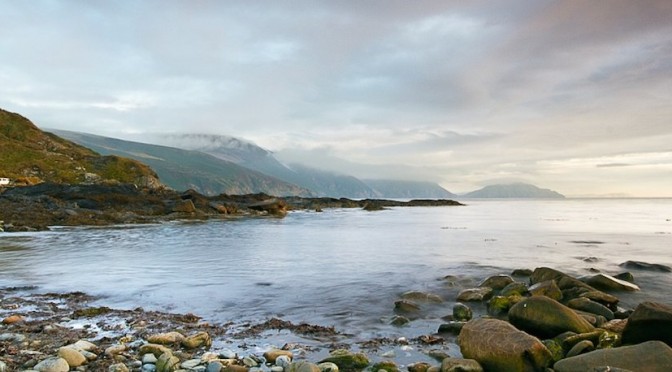My very first piece of reasearch was into the involvement of John Stanley in the affairs of the Island.
From the history of John Stanley, contained in the “House of Stanley” written by John Seacome in 1737 and contained in the Isle of Man archives, it is insinuated that John Stanley came from humble origins but became King of the Island within his lifetime.
Seacome makes it appear that all this was just a natural progression, facilitated by John’s steadfast service to the crown, but it leaves many questions unanswered.
Knut’s Empire
 Around 1010, Knut of Denmark extended his empire to include England, and the Viking possessions of the Isles, Western Scotland, Eastern Scotland and the Isle of Mann.
Around 1010, Knut of Denmark extended his empire to include England, and the Viking possessions of the Isles, Western Scotland, Eastern Scotland and the Isle of Mann.
The Danish Empire then collapsed, England, Eastern Scotland and Eastern Ireland were invaded by the Normans and the ownership of the isles reverted to Norway.
Strategic importance
 From the time of the Edmund de Bruce invasion of Ireland, the Isle of Mann acquired a increasing strategic importance.
From the time of the Edmund de Bruce invasion of Ireland, the Isle of Mann acquired a increasing strategic importance.
The English wanted control of the passage between Scotland and Ireland and bases in the Isle of Mann made that control possible.
In the Isle itself, proud of it’s Scandinavian heritage, there was a desire to continue to be ruled by their hereditary kings.
Intermarriage
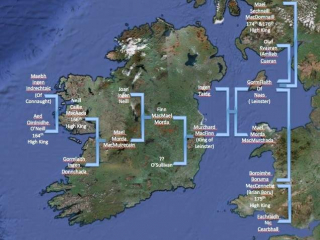 The story of the Kings of Mann became entangled with the Irish high kings because of Gormflaith of Nass, who married not only Brian Boru but also Olaf Kvarren. This lady is particularly important as many of her descendants are important to the story.
The story of the Kings of Mann became entangled with the Irish high kings because of Gormflaith of Nass, who married not only Brian Boru but also Olaf Kvarren. This lady is particularly important as many of her descendants are important to the story.
Kings of Mann
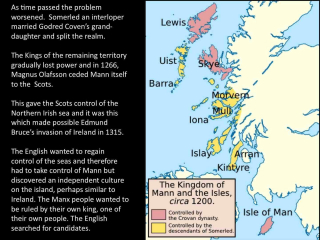 Her grandson, Godfred Craven became King of Mann and was followed as such by his son Olaf (also known as “the Red”) and his grandson Godfed (also known as “The Black”)
Her grandson, Godfred Craven became King of Mann and was followed as such by his son Olaf (also known as “the Red”) and his grandson Godfed (also known as “The Black”)
 Olaf’s son-in-law Somerled, at that time lord of Argyll, invaded the Isle and Godfred the Black fled to Norway. The various contenders nominated as Kings of Mann in the fourteenth century were all descended from members of these families.
Olaf’s son-in-law Somerled, at that time lord of Argyll, invaded the Isle and Godfred the Black fled to Norway. The various contenders nominated as Kings of Mann in the fourteenth century were all descended from members of these families.
William Montacute
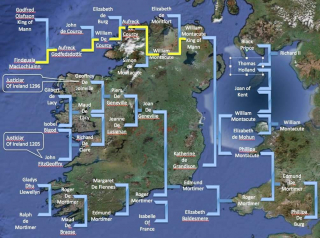 William de Montacute, the Earl of Salisbury was descended from Olaf the Black.If the fact that Olaf had been ejected by Somerled and the island had been subjected to direct rule by Norway, England and Scotland in the intervening period, is ignored, William’s claim was good. It suited the English cause to declare the island as independent and offer William as King.
William de Montacute, the Earl of Salisbury was descended from Olaf the Black.If the fact that Olaf had been ejected by Somerled and the island had been subjected to direct rule by Norway, England and Scotland in the intervening period, is ignored, William’s claim was good. It suited the English cause to declare the island as independent and offer William as King.
He was acceptable to the islanders who felt themselves once again to be responsible for their own destiny.
Sale of a kingdom?
 However in 1392, William’s son sold the rights to Mann to William le Scope, possibly as a result of killing his own son during a tournament.
However in 1392, William’s son sold the rights to Mann to William le Scope, possibly as a result of killing his own son during a tournament.
Scope also had a claim to the kingship but not as strong as the Montacute’s. The claim came through through Scrope’s mother. The claim originated in a cousin of Godfred Craven whose daughter married into welsh nobility.
William le Scope
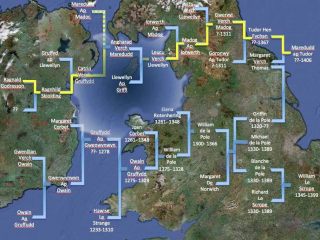 This diagram shows his claim came through the De La Pole family who therefore had the same claim. Yes the diagram is correct. Owain ap Gruuydd was also Lord de la Pole.
This diagram shows his claim came through the De La Pole family who therefore had the same claim. Yes the diagram is correct. Owain ap Gruuydd was also Lord de la Pole.
For convenience this diagram also shows how close the De La Pole family were to the Tudors. The upper part of this diagram shows that Tudor family also had its roots in the Kings of Mann but from an illegitimate child, Ragnald Godresson. Margaret Verch Thomas was a descendant of both Welsh and English royalty. Her marriage to members of both the De La Pole and Tudor families meant that there was a very close but not necessarily harmonious relationship between the two families.
Henry Percy
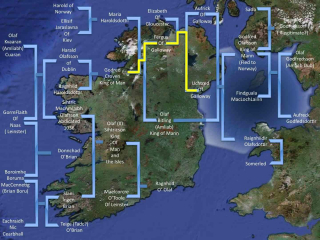 in 1399 William Le Scrope chose the wrong side in one of the revolts against Henry IV was beheaded and his property including the Isle of Mann became part of the royal estate.
in 1399 William Le Scrope chose the wrong side in one of the revolts against Henry IV was beheaded and his property including the Isle of Mann became part of the royal estate.
Because the english policy was to retain Mann as an independent kingdom yet another candidate with a claim to the throne of Mann, this time it was Henry Percy whose claim again originated with Godfred Craven but this time through Craven’s granddaughter, Uchtred of Galloway.
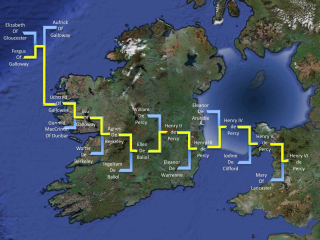 Presumably because of their homeland lay close to the Scottish border this line contains much Scottish blood. The appointment did not last long. Henry Percy in association with Owen Glendower and Edmund Mortimer again revolted against Henry IV. He did not succeed and though he was still fighting against Henry in 1408 his possessions including the Isle of Mann, were again confiscated by the King in 1405.
Presumably because of their homeland lay close to the Scottish border this line contains much Scottish blood. The appointment did not last long. Henry Percy in association with Owen Glendower and Edmund Mortimer again revolted against Henry IV. He did not succeed and though he was still fighting against Henry in 1408 his possessions including the Isle of Mann, were again confiscated by the King in 1405.
Another person was required to be King of Mann. This time the choice fell on John Stanley.
John Stanley
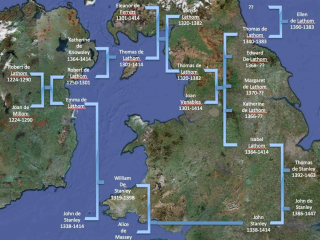 This is the conventional view of the marriage between John Stanley and Isabel LathomThis line entered the Lathom family through Alianore de Ferrers and therefore was not shared by John Stanley. Ihis is a second view of the”conventional”view of the Stanley Genealogy which is also shown at the beginning of the segment on “The Perfect Knight”.
This is the conventional view of the marriage between John Stanley and Isabel LathomThis line entered the Lathom family through Alianore de Ferrers and therefore was not shared by John Stanley. Ihis is a second view of the”conventional”view of the Stanley Genealogy which is also shown at the beginning of the segment on “The Perfect Knight”.
This explains why the Stanley family deliberately confused the issue of John II’s parentage and why they were supported by the English establishment in doing so. It was essential that John II had an unassailable claim to the kingship of the Isle of Mann.
As it turned out it was unassailable. The Stanleys and their descendants the Murrays ruled Mann as an independent nation for more than three hundred years.
